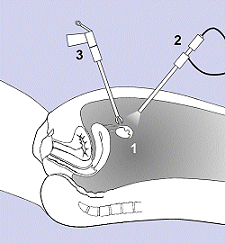|
Treatment
The presence of endometriosis can be confirmed by means of a laparoscopy (from Gr. lapara: flank and skopein: to see). A larascopy is a surgical procedure, normally performed under general ansthesia: A small incision is made in the abdomen, and the abdominal cavity is expanded by inserting carbon dioxide gas so that the pelvic structures can be seen more clearly. With the help of an inserted tube-like viewing instrument, the laparoscope, the doctor then can look inside and inspect the surface of the uterus, the ovaries, and the Fallopian tubes. Another small incision allows the insertion of a second tube, the probe. It can remove a small portion of tissue for testing. In some mild and moderate cases, the endometrial tissue can already be entirely removed during this diagnostic exploration.
Obviously, once endometriosis has been confirmed, the same technique can be used to remove it. Thus, a laparoscopy can also serve the purpose of surgical treatment. However, surgery is not always needed. The treatment varies with the location and stage of the disease, the age of the patient and her wish to become pregnant. While there is no cure for endometriosis, there are several ways of managing the symptoms. Depending on the individual case, it may be sufficient to relieve pain and heavy bleeding by taking appropriate drugs. Some women also find complementary treatments useful, such as acupuncture, herbal medicine or homeopathy. Certain hormonal medicines may shrink or slow down the growth of endometrial tissue. Treating infertility usually requires special measures suited to the individual case. Finally, one must know that, even after surgery, endometriosis can return. All in all, since the disease appears in so many different forms in different women, a careful diagnosis and extensive communication between doctor and patient are essential.
 |
Laparoscopy
A laparoscopy can be used not only in diagnosing, but also in treating endometriosis. In the second case, not only a small sample, but as much of endometrial tissue as possible is surgically removed. Our picture illustrates the first case. It shows the gas-filled abdominal cavity (1), the laparoscope shining its light on one of the two ovaries (2), and the probe (3). |